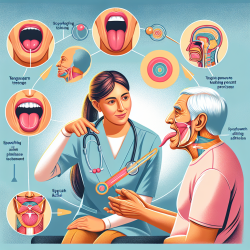Dysphagia, a condition characterized by difficulty swallowing, is a prevalent issue among older adults. It often arises due to conditions such as stroke or progressive diseases that become more common with age. The gradual loss of muscle bulk and strength, known as sarcopenia, exacerbates this risk. However, recent research offers promising insights into managing dysphagia through targeted tongue-pressure training.
The Study: Tongue-Pressure Training Protocol
A study titled "Improvements in tongue strength and pressure-generation precision following a tongue-pressure training protocol in older individuals with dysphagia: Three case reports" explores the effectiveness of a specific training protocol. Conducted by researchers at the Toronto Rehabilitation Institute and the University of Toronto, this study involved three older adults with dysphagia who underwent a series of isometric strength exercises and pressure accuracy tasks using the Iowa Oral Performance Instrument (IOPI).
The participants showed significant improvements in both tongue strength and precision in generating pressure. These enhancements were linked to better bolus control during swallowing and improved dietary intake. The results suggest that tongue-pressure training could be a valuable rehabilitative tool for managing dysphagia in various populations.
Implications for Practitioners
For speech-language pathologists and other practitioners working with dysphagia patients, incorporating tongue-pressure training into therapeutic protocols could enhance treatment outcomes. The study highlights several key takeaways:
- Strength and Precision: Emphasizing both maximum pressure capacity and accuracy in generating submaximal pressures can lead to significant improvements in swallowing function.
- Biofeedback Utilization: Using devices like the IOPI to provide real-time feedback can help patients achieve targeted pressure levels more effectively.
- Customized Targets: Setting individualized targets based on initial assessments can optimize therapy sessions and track progress more accurately.
The Need for Further Research
While the findings are promising, they are based on a small sample size. Further research involving larger and more diverse populations is necessary to validate these results. Future studies should also explore the temporal aspects of tongue pressure generation to fully understand its role in bolus control.
The growing prevalence of dysphagia among aging populations underscores the need for effective therapeutic interventions. By advancing our understanding of tongue-pressure training, we can improve quality of life for individuals affected by this condition.
To read the original research paper, please follow this link: Improvements in tongue strength and pressure-generation precision following a tongue-pressure training protocol in older individuals with dysphagia: Three case reports.










